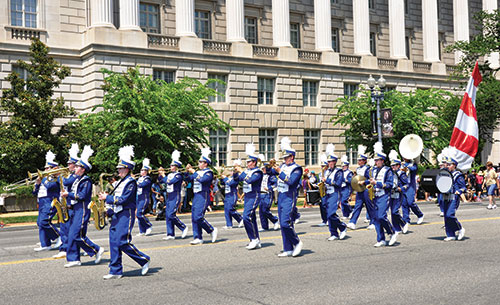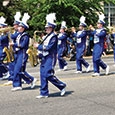A smaller marching band – generally containing fewer than five wind and brass players per part and fewer than ten total percussionists – can achieve the same level of excellence as a larger one. Although arranging and composing music for small marching bands can be challenging, the following planning and writing strategies can be effectively employed for program success. Many are specific to small marching band writing practices, but some are essential to musical writing for marching bands of all sizes.
Hiring an Arranger
Marching band directors who prefer not to arrange the music themselves can hire arrangers to do so. The director may hire one arranger to write all wind, brass, percussion, and front ensemble/electronics (if any) parts or separate arrangers for each section. Before signing a contract directors and arrangers should meet to discuss the director’s vision for the season, including the ensemble’s strengths, weaknesses, prior musical arrangements, and target audiences. Arrangers must learn the show’s logistical needs, including the band’s size, instrumentation (winds and percussion), any section range restrictions, special musical and visual effects, and how music will be transferred. Finally, the director must inquire about the arranger’s revision policy and timelines. When evaluating arrangers, make sure they fully understand form, structure, harmonic and melodic content for a small marching band, including comprehensive knowledge of every instrument’s pedagogy in the context of grade-level appropriate music.
If multiple arrangers are hired, a program coordinator (who could be the band director) must ensure the program’s vision and manage its visual concept to synchronize the musical and visual packages. Once music has been selected, the director, arranger, program coordinator and/or staff should create a storyboard planning guide. For this purpose, the wind arranger must be informed of specific visual requests for the show, so that the score can include sufficient counts for effects to develop, execute and transition to the next section or effect in the actual performance. The arranger must coordinate and communicate all musical and visual effects in the storyboard.
Show Design, Music Selection, and Arranging Basics
The design of a field show for smaller marching ensembles should include similar characteristics of larger groups, such as impact points, general effect, and emotional contour. However, the length of the show and the number of pieces performed must also be considered: shows built around arrangements longer than two minutes are often difficult for smaller bands to sustain, so a faster-paced show of multiple short arrangements is recommended. This gives small bands an advantage, as great marching band repertoire will include diverse changes within the style, tempo, key, and dynamics of the music.
Good ideas for music choices include repertoire written for a smaller group, such as a chamber ensemble or a Broadway musical pit orchestra. Large symphonic works should be avoided. In addition, arrangements for smaller ensembles should avoid long wind-section sustains that could be assigned to the electronic or percussion sections. Wind instruments are best staged together for section features, and electronic instruments could expand the ensemble’s overall sound.
Instrumentation
Balanced SATB instrumentation among the woodwind, brass, percussion, and electronic sections is key to small marching band success. If this balance cannot be achieved with current personnel, try to switch instruments, players, or personnel and work for ensemble balance. This will produce a variety of color in orchestration, even with a reduced number of parts and players.

Woodwinds
In a small marching ensemble, the woodwinds can often carry melody without the same fatigue with which brass players struggle. In this case, the woodwinds should be audible within proper orchestration and musical balance. Stage them toward the front of the form and score the brass and percussion more lightly and at a softer dynamic. Arrange for a complement of flute, clarinet, and alto, tenor, and baritone saxophones.
Directors often switch all flute players to piccolo, thinking this will ensure the piccolo part’s audibility. This, however, can make the band’s soprano voice too prominent for good balance, and trying to tune multiple piccolos is problematic.
Avoid clarinet throat-tones (G4 through Bb4), as they are notorious for their stuffy sounds, sharp intonation, and lack of overall projection.
Alto and tenor saxophones best support woodwind textures. If the arrangement has a woodwind feature, these saxophones should play in unison, similar to jazz band voicing, and the baritone saxophone should play an octave lower.
A baritone saxophone can fill out the bass voice if low brass is absent from the ensemble. Conversely, a single bass clarinet player will not be heard in the scope of a full marching band. Bass clarinetists should be switched to another instrument such as a baritone saxophone or soprano clarinet for stronger musical effect in the section.
Brass
The brass section is the melodic power within a small marching ensemble, and because of low numbers within a small band the brass players are often soloists. The arranger must keep endurance, fatigue, confidence, and projection in mind when arranging for brass and should take special
care not to overextend the trumpets and mellophones in the higher registers too frequently and for too long.
When recruiting for a small marching band’s brass section, aim for a full complement of trumpet, mellophone, tenor brass (trombone and baritone), and tuba. If one of each instrument is not possible, consider switching players to ensure proper balance. If possible, consider using all trombones or all baritones for better blend of sound.
In brass parts, use closed voicings for the upper brass and open voicings for low brass to achieve a rich, sonorous sound. In addition, chord roots and fifths are more safely doubled than thirds and sevenths.
Battery Percussion
The battery distinguishes a marching band from a concert marching band by adding excitement with rhythmic complexity. Aim for a pyramid balance of snare drums, tenors and bass drums in a small band. If the band has only a few percussionists, the battery could combine the front ensemble with grounded or concert percussion, and the multi-tenor drums can be omitted.
Front Ensemble
Too often the front ensemble is a last-minute addition to a small band, but arrangers can take advantage of this section to introduce new sounds and make arrangements more original. Like woodwinds, a small band’s front ensemble can accent the winds, add texture with a variety of pitched and non-pitched percussion, carry the melody, and offer a rest for the smaller wind section. Consider having keyboard percussion players use four mallets to add depth and projection to the sound.
Electronics and Amplification
Electronics can give a small band a fuller, richer, more sonorous sound. Electronic instruments could include synthesizers, electric and bass guitars, electronic drum sets, samplers, and sampler trigger pads. Creative arrangement of these timbres can change, and even enrich, the sound of a small ensemble. Even a simple synthesizer part of a few sustained note chords can fill out the empty sound often associated with very small bands.
Amplification of mallet instruments and winds can also augment the overall ensemble sound in a more natural way than electronic sounds can do. Amplify as many instruments as the band budget allows. The most commonly amplified ones are mallet instruments and wind soloists. In addition, sideline microphones can amplify the entire ensemble. If this is done, be sure not to stage the battery in front of the microphones.
The smallest marching bands can sound powerful and present a variety of color when scored properly. A common arrangement pitfall is to write too many parts (two or three clarinet and trumpet parts, multiple low brass parts, divisi parts). A small marching band can generate a powerful effect through velocity, creative programming and ideas, and general excellence in musicianship. To present a full, rich, dynamic sound with limited players, a reduced number of parts is recommended. For small bands with more than 30 players, consider scoring parts for piccolo/flute, clarinet, alto saxophone, tenor saxophone, baritone saxophone, first and second trumpets, mellophones, tenor brass, tuba, synthesizer, electric bass, bells, vibraphone, xylophone, marimba, accessory percussion (including crash cymbals), snares, tenors, and bass drums.
For a band this size, have clarinets double either the flute or first trumpet. Alto saxophones can double flute and clarinet or mellophone, and tenor saxophones can double the same parts as the altos or the tenor brass. If a band has enough trumpets for two parts, have mellophones double second trumpet. Otherwise they can double alto saxophones. There should only be one part for tenor brass, although this part can have some divisi sections. In addition, tenor brass can double the tuba part as needed. Baritone saxophone should also double tuba.
The standard block scoring system is a useful tool for starters. In this, write the melody in trumpet 1, with flute and clarinet doubling the trumpet an octave higher (or in unison, if there are enough clarinets for a second part). Have second trumpets, horns, and alto and tenor saxes play harmony, while all other wind instruments play the bass part.
For Fewer than Thirty Players
If a band has fewer than thirty members, use a reduced score with one part each for piccolo/flute, clarinet, alto saxophone, trumpet, mellophone, tenor brass/woodwinds, tuba/baritone sax, synthesizer, electric bass, metal pitched percussion, wooden pitch percussion, accessories, snares, tenors, and bass drums. In this situation, the doublings mentioned above are still the best guideline. Notable differences include keeping the tenor saxophone with the tenor brass, having bells and vibes (metals) on one part and xylophone and marimba (woods) on one part.
Projection and Resonance
Keep the arrangement and orchestration simple. Performance excellence will often occur with clear, uncomplicated rhythmic parts and orchestration. For ideal projection and power, fewer lines are better for a smaller ensemble. Scores for small bands should not have more than three total lines: melody, harmony/counter line, and bass. If the flutes, clarinets and first trumpet carry the melody, the harmonization could be in the second trumpet, saxophones and mellophones, with the low reeds and low brass providing the bass line. A full sound can also be produced if the alto voice has a countermelody that fills in missing chord members. An arranger might be tempted to include moving woodwind lines, but if a small band has few woodwind players, careful attention to balance is important. A doubling of the brass for power and volume may be a better choice. If the band is on the field and lines cannot be heard, consider why. Balance, scoring, and player ability might all be factors. Rewrites should be minimized, but implemented if necessary.
Understanding the power ranges – the most resonant and projectable ranges of each instrument – will help produce optimal sound projection for a small marching band. The ranges noted below

should be used as a guideline and can change depending on the musical context and the abilities of the ensemble. In general, however, writing outside of these ranges could jeopardize tone quality and projection, although an exception can be made for more delicate textures, which are best produced by staying in low to middle registers and using diminished instrumentation.
Key selection should allow all instruments in a small band to project and resonate despite the band’s parameters. The best small marching band keys are F, Bb, Eb, Ab, and C major, and their relative minor keys. All of these keys resonate well on brass and woodwind instruments, while a key with more flats will produce a darker sound. The proper timbre, the positioning of melodic lines, and the tonal requirements of key technical passages should influence the arranger’s key selection. It is worth noting that when the brass instruments play a note fingered with second and third valves, intonation and technical problems might occur, weakening a small marching band’s tonal power.
Unisons and octaves will project more than multiple chord tones and divisi parts. Dividing an instrument into two or more parts takes focus away from the top line and thins the sound. Consider using woodwinds and melodic percussion to imply harmony. Triadic harmony works best with a smaller ensemble. Sevenths, ninths, and elevenths are best suited for larger ensembles because there are enough members to play each chord tone. If a small band arranger uses triadic harmony and must omit a chord tone, omitting the fifth is best. Avoid doubling the third.
To voice the winds for power, use closed scoring in high voices and open scoring in low voices, following the overtone series, which should be used as a reference to ensure the arrangement is not missing an important chord tone order. Bear in mind, louder dynamics often have the winds scored higher in the staff and softer dynamics lower in the staff.
Scoring Tips
Even in a small band, the winds need not play the entire time. Giving sections resting moments is physically necessary for the brass. Percussion and electronics can carry the melodic content and effect during these rest periods. Similarly, it is best to create a separate mallet part or have the mallets rest so the woodwinds can be clearly heard.
A smaller band’s woodwind section might have only a few players per part and need more doubling than SATB voicing can provide. This approach to the woodwind choir can be appropriate in a woodwind feature and in some full-ensemble moments. Smaller woodwind sections can create harmony when isolated, so the SATB pyramid can be clearly heard.
Use dynamics, especially pianissimo. Remember, softer dynamics make louder dynamics sound more powerful by contrast. The arranger should create musical lines and include phrase markings.
Consider the pacing of sustains, as stagger breathing might not be a viable option because of the small number of players per part. Avoid holding sustains in the winds for longer than twelve counts. Sustains sound best in electronics, with percussion rhythmic accompaniment driving the effect. The winds can play ostinatos and layer into the texture. Another useful trick is to maximize layering by starting an effect with the percussion, adding the woodwinds, and resolving the sustained effect with the brass.
Staging
Although drill and staging are a visual element, a small marching band must be properly staged to sound its best. In general, it is best to keep the band between the 30-yard lines and before the front hash, with the melody near the front of the field so it can be clearly seen and heard. If the band has a moving battery, keep it in the pulse area for support and rhythmic clarity. Do not stage percussion in front of the melody, and do not allow percussion parts to overplay the ensemble.
If balance and blend are a struggle, consider placing the front ensemble, percussion and electronics behind the band to support the wind sound from the back. You might also stage trumpets towards the back of the form so they play through the bass voices and blend.
Final Thoughts
Theoretical voicing, orchestration, and planning work well on paper, but practical experimentation, knowledge, and implementation based upon the sounds you hear from your band and the competency level of your students ultimately determines the scoring and arranging. Every band is different; arrange to your band’s strengths, while aiming for a musical and visual focus. Do not try to overplay or overblow the band’s sound. Strive for a sonorous, rich sense of tone, and balance your ensemble sound among all sections. Regardless of the band’s size, creativity and excellence will always be rewarded.






